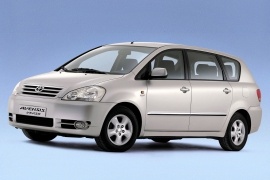TOYOTA Avensis Verso Models/Series Timeline, Specifications & Photos
First production year: 2001
Engines: Diesel, Gasoline
Body style: Van
Toyota offered the second generation of the Avensis in a few body shapes, including an MPV model named Verso, which it introduced on the market in 2001.
The Japanese carmaker took its time to introduce the Avensis Verso, and while some countries received it in 2001, others got it only in 2003. Australians were the luckiest ones, receiving right from the start. While its Avensis started to get more attention from customers thanks to its comfortable ride and wide engine range, the Verso was noticed for its interior space. In Europe, it faced harsh competition from the local carmakers. The mid-2000s was still a good time to offer an MPV on the market before the SUVs came and change the game.
With its high stance and tall greenhouse, the Avensis Verso shared some design cues with its sedan or station-wagon sibling. Its headlights showed a double-curved line on the inbound area. Its fat bumper with a straight lower grille tried to make the vehicle look very docile. There was not any aggressive line on the car. On the sides, the long roofline resembled the one on the Avensis Station Wagon, but the D-pillar was way thicker, with a triangular shape that formed a big blind spot for the rear three-quarter. It was a 2-3-2 seating configuration, with the last row being accessible via a tilt&slide second row of seats.
Under the hood, Toyota installed a narrower choice of engines when compared it to the sedan version. It was available with a 2.0-liter gasoline engine and a turbo-diesel.
Toyota introduced the minivan version of the Avensis in 2001, trying to take a bigger slice of the pie and offering a better alternative to the Avensis Wagon.
The Japanese automaker created the Verso lineup of vehicles based on the Yaris, Corolla, and Avensis. Thus, it fiercely competed against other brands that already had a thing or two to say on the market. Strangely though, the Avensis Verso was launched before the Avenis' second generation, with which it shared its underpinnings. But that didn't stop the car from being successful in several markets. Moreover, it even won the Australia's Best People Mover award.
The Verso's look was friendly, sporting big, triangular headlights that flanked a two-slat grille. Its short hood and the massive windshield had the right angle between them, so the car could've been considered a minivan. On the profile, the Avensis Veros featured a greenhouse fitted with large windows. Finally, at the back, the almost vertical tailgate offered easy access to the car's trunk. The taillights were split between the rear quarter panels and the tailgate since it was not a vehicle designed for the U.S. market.
Inside, the Avensis Verso offered room for up to seven passengers seated in three rows. As usual for these kinds of vehicles, the second and the third rows could've been folded flat, thus creating a huge amount of space. The dashboard looked quite modern for its time, with a dark instrument cluster fronting the driver and a center stack where Toyota installed the HVAC and the audio system. Unlike other minivans, the Avensis Verso featured a floor-mounted gear shift.
Under the hood, the Japanese minivan offered a choice of gasoline and turbo-diesel engines. Depending on the version, the transmission was either a five-speed manual or a four-speed automatic.

